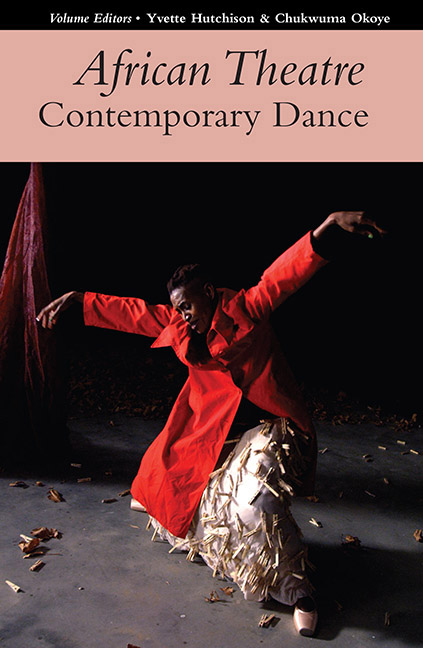Book contents
- Frontmatter
- Contents
- Notes on Contributors
- Introduction
- I Dance
- James Mweu & Kunja Dance Theatre Contemporary dance as African cultural production
- Looking Behind the Mirror Challenging representationalism in contemporary dance in postcolonial African contexts
- Decolonising the Stage Reflecting on Mamela Nyamza in a Canadian-hosted South African performance festival
- Unmuting South African Citizenship through Integrated/Disability Dance
- From Television to the Streets The rise & rise of dance-based advertising in Nigeria
- Dance Photo Essay ‘Untitled’: FOD Gang's environmental activism
- II Open Section
- Book Reviews
Unmuting South African Citizenship through Integrated/Disability Dance
from I - Dance
Published online by Cambridge University Press: 26 July 2019
- Frontmatter
- Contents
- Notes on Contributors
- Introduction
- I Dance
- James Mweu & Kunja Dance Theatre Contemporary dance as African cultural production
- Looking Behind the Mirror Challenging representationalism in contemporary dance in postcolonial African contexts
- Decolonising the Stage Reflecting on Mamela Nyamza in a Canadian-hosted South African performance festival
- Unmuting South African Citizenship through Integrated/Disability Dance
- From Television to the Streets The rise & rise of dance-based advertising in Nigeria
- Dance Photo Essay ‘Untitled’: FOD Gang's environmental activism
- II Open Section
- Book Reviews
Summary
During apartheid, the arts in South Africa were mobilised as ‘a weapon of the struggle’ to engage audiences with disavowed issues; the toyi-toyi is an iconic example of embodied activist resistance. However, in 1989 at an ANC in-house seminar on culture, Albie Sachs presented a paper in which he argued that, while this approach to culture had been necessary, it had skewed the imagination and creativity of South Africans, resulting in ‘the multiple ghettos of the apartheid imagination’ (1991: 187). He insisted that artists should shift from viewing culture as something ‘purely instrumental and nondialectical’, to something more open, as an imaginative way to ‘remake ourselves’ (189). The new challenge, he argued, was to find an aesthetic that has the ‘capacity to expose contradictions and reveal hidden tensions’, to find ways of expressing a new sense of cultural diversity and political pluralism (188, 190– 3). He called for the use of imagination to unlock these new ways of thinking about cultural production, and I would add South African citizenship. The Truth and Reconciliation Commission (1996–98) did much to address disavowed memories and histories, including gendered violence, and inclusive citizenship. However, we must consider how these challenges can and have been extended through the arts. Thus, I want to consider how inclusive/ integrated/ disabled Dance in South Africa is both exposing contradictions and unlocking new ways of thinking about cultural production. I deploy Bree Hadley's (2014) arguments on the importance of seeing, imaging and imagining the Other as my point of departure for analysing citizenship through the lens of disability dance.
The European Commission defines active citizenship as: ‘Participation in civil society, community and/or political life, characterised by mutual respect and non-violence and in accordance with human rights and democracy’ (Hoskins et al. 2006: 10). The South Africa Bill of Responsibilities for the Youth of South Africa (2012), which emerges from the Constitution of the Republic of South Africa, includes the right to equality, the right to dignity, the right to work, the right to freedom and security of the person. However, this is not the case for many in South Africa, and certainly not true for people living with disabilities.
- Type
- Chapter
- Information
- African Theatre: Contemporary Dance , pp. 67 - 89Publisher: Boydell & BrewerPrint publication year: 2018



